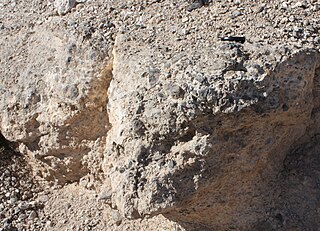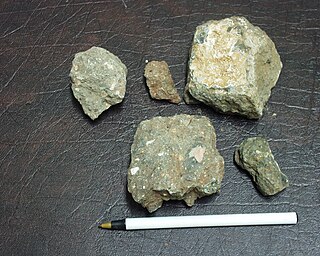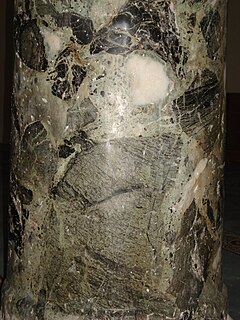 W
WBreccia is a rock composed of broken fragments of minerals or rock cemented together by a fine-grained matrix that can be similar to or different from the composition of the fragments.
 W
WThe Elliott County Kimberlite was discovered in Elliott County, Kentucky, by Albert R. Crandall in 1884 over two years before Carvill Lewis named a similar porphyritic peridotite occurring near Kimberley, South Africa, a kimberlite. It occurs as three separate elongate intrusive bodies 1/4 to 1/2 mi in length and a few hundred feet in width, within an area of about a square mile. The rock is a dark-green peridotite (kimberlite) composed of serpentinized olivine and a number of accessory minerals, including phlogopite, pyrope, calcite, enstatite, magnesian ilmenite, and others. Xenoliths, mainly of shale, and igneous rock inclusions are abundant in the three intrusive bodies as described by William Brown in 1977. Detailed petrographic descriptions of the peridotite are presented by Diller in 1887 and Bolivar in 1982. The peridotite has been dated to Early Permian time by K-Ar and Rb-Sr dating of xenocrystic biotite from one of the intrusive masses, however more recent evidence points to a Cretaceous emplacement. The rock is relatively nonresistant, is commonly disintegrated to as much as 50 feet, and usually asserts no topographical expression. Unweathered rock is hard, dark greenish black and weathers to grayish olive. The saprolite is yellowish to reddish brown and strewn with garnet and ilmenite fragments and xenoliths. Several attempts have been made to find diamonds in the kimberlite with no success.
 W
WFault breccia, or tectonic breccia, is a breccia that was formed by tectonic forces.
 W
WHeavitree stone is a type of breccia stone, red in colour, of very coarse texture and prone to weathering, which occurs naturally in the parish of Heavitree near the City of Exeter in Devon, England. It was quarried in the area from about 1350 to the 19th century, and was used to construct many of Exeter's older buildings, including Exeter Castle, the old city walls, and many of the almshouses and parish churches. Many ancient buildings in Exeter made of Heavitree stone were destroyed by enemy bombing during World War II. It was first referred to by Sir Henry De La Beche in 1839, as the "Conglomerates of Heavitree".
 W
WHyaloclastite is a volcanoclastic accumulation or breccia consisting of glass fragments (clasts) formed by quench fragmentation of lava flow surfaces during submarine or subglacial extrusion. It occurs as thin margins on the lava flow surfaces and between pillow lavas as well as in thicker deposits, more commonly associated with explosive, volatile-rich eruptions as well as steeper topography. Hyaloclastites form during volcanic eruptions under water, under ice or where subaerial flows reach the sea or other bodies of water. It commonly has the appearance of angular flat fragments sized between a millimeter to few centimeters. The fragmentation occurs by the force of the volcanic explosion, or by thermal shock and spallation during rapid cooling.
 W
WThe Lake Ellen Kimberlite is a poorly exposed volcanic breccia located about 10 miles (16 km) northeast of Crystal Falls in the Upper Peninsula of Michigan. The first publication in 1981 describing the feature led to speculation that this or similar kimberlites in the area might have been the source of the diamonds discovered a century before in Wisconsin as well as a period of exploration by several minerals firms.
 W
WNeugrund breccia is a type of rock consisting of gneissic breccia and amphibolite originating from the Neugrund crater.
 W
WVerd antique, also called verde antique, marmor thessalicum, or Ophite, is a serpentinite breccia popular since ancient times as a decorative facing stone. It is a dark, dull green, white-mottled serpentine, mixed with calcite, dolomite, or magnesite, which takes a high polish. The term verd antique has been documented in English texts as early as 1745.